Maximizing Save Performance and File Size with SOLIDWORKS Configurations
Maximizing Save Performance in SOLIDWORKS
Nobody wants to sit around and wait for their files to save. It’s a waste of time and we can probably speed it up with some tweaks. But what should we do to make this better? Well, you’ve probably used configurations or heard of them in the past, so we can clean those up. Additionally, we should look at our display settings in SOLIDWORKS. Ideally, the files are fine enough detail that we can easily know what we’re looking at but not so detailed that it bloats the file. With those as our backdrop, let’s look at a few best practices to help you maximize your save performance with SOLIDWORKS.
How Configurations Impact Save Performance
Configurations in SOLIDWORKS allow you to depict multiple versions of a model in a single file. They’re especially useful as simplifications with non-critical features or components removed. You can also use them as representations of distinct model states (e.g., extended vs. collapsed, pre- vs. post-machining). If you’re not careful, though, adding configurations to your model can worsen performance, particularly when saving the file.
When you save a model, SOLIDWORKS stores information related to the active configuration at a minimum. (It’s often more than just the active configuration, but I’ll get to that later.) Though there are other contributing factors, the size of the file tends to be driven by that active configuration’s feature data (the calculations required to build its feature tree) and display data (its graphical representation). So, the more complex the active configuration is, the larger the file will be and the longer it will take to save.
To prove this point—and to show some easy tricks to keep things running smoothly—let’s look at this engine head model. It has four configurations, differentiated only by the number of active features. To get a general sense of the complexity of each configuration, I’ve listed their feature and face counts below:
- Full: 112 features, 1272 faces
- Simplified: 68 features, 750 faces
- Rocker Box Fillet State: 59 features, 649 faces
- Spartan: 51 features, 349 faces
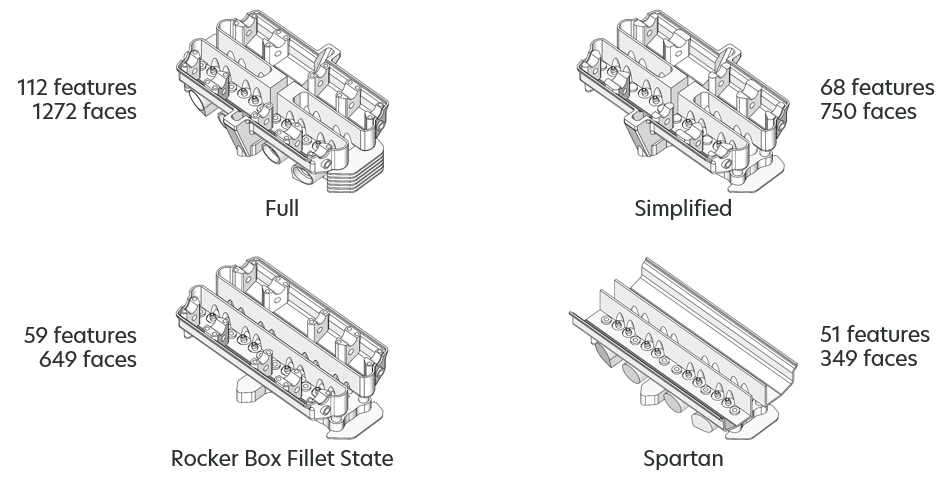
Influence of the Active Configuration on Save Performance
In order to see how the active configuration affects performance, I saved the engine head model in each configuration and recorded the resulting file size. When saving the model with the Full configuration active, the file size was around 3300 KB. This value jumps around as I save, but it was usually in that 3300 KB area. With the Simplified configuration active, the file size was close to 2000 KB. With Rocker Box Fillet State, it’s about 1750 KB. And finally, with Spartan, the size is only around 1250 KB.

Clearly, the active configuration impacts the file size. However, I had to be kind of careful to measure this correctly. Notice in each scenario that only one configuration—the active one—has a checkmark. The rest have dashes. Dashes indicate that SOLIDWORKS isn’t caching the feature data for those model configurations.
Any configurations with checkmarks, whether green or grey, are being remembered by the model, so to speak. The difference in color is just to differentiate the active (green) configuration from the inactive (grey). If you’re looking at your ConfigurationManager and see a bunch of checkmarks, you’re likely storing a lot more data in your file than you need.
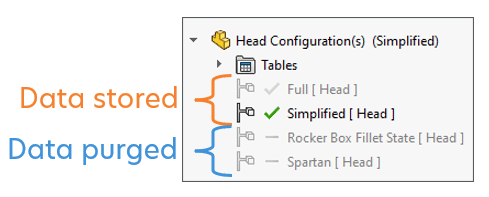
Feature Data
Each time you save, SOLIDWORKS isn’t necessarily saving information related to the active configuration alone. It’s also saving feature data for the inactive configurations that have a checkmark. The more configurations you have checked, the larger the file will be, as you can see from the numbers in the image below. With all four configurations being cached, my file is more than twice the size as when I had the Full configuration on its own.
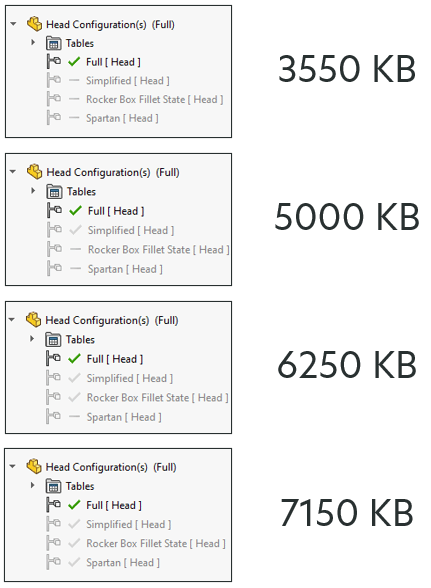
(I’m not entirely sure why the one with only the Full configuration came out to 250 KB higher this time than what I’d recorded for that situation in the last example. I started seeing 3550 KB consistently though, so something must’ve changed with the model behind the scenes in between my first testing and this one.)
Normally, when you change from one configuration to another, SOLIDWORKS will keep the feature data for the one you switched out of, meaning you’ll see the grey check next to it in the ConfigurationManager. This enables quicker toggling between configurations in the future, as it requires less effort from SOLIDWORKS to activate a cached configuration than one that’s been unloaded.
Unload a Cached Configuration
There are a few ways to unload a cached configuration. Editing a feature, whether you change any parameters or not, will typically cause the inactive configurations to lose their checks. The next time you activate one of those configurations, SOLIDWORKS will need to recalculate it to determine whether that feature edit had changed the model from the last time it was built.
If you right-click the top-level part name in the ConfigurationManager, there’s a category called Rebuild on Save Mark. The options in this flyout menu can be used to control how feature data is stored.
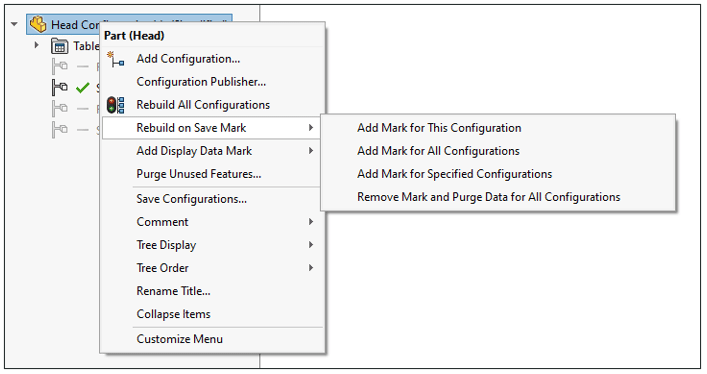
The “Add Mark” options are used to apply a Rebuild on Save Mark to certain configurations. Attaching a Rebuild on Save Mark to a configuration forces SOLIDWORKS to rebuild it every time you save the file; in other words, the program will cache its feature data. This helps you ensure that certain configurations are up to date and can be quickly activated later. This also, though, increases the amount of information SOLIDWORKS saves with the document, so files will be bigger and saves will be slower.
You’ll see the Save floppy disk icon next to any configurations that have one of these marks applied to them.

The option at the bottom of the flyout menu, “Remove Mark and Purge Data for All Configurations,” gets rid of any Rebuild on Save Marks you’ve applied and unloads all of the cached data. The active configuration’s data will still be kept, but all inactive configurations will then show the grey dash icon.
There is also a way to automatically purge data from inactive configurations every time you save the document. This option is called “Purge cached configuration data,” found in the Performance category of System Options.

This setting will not impact configurations that have a Rebuild on Save Mark. Those configurations will still be rebuilt and their data will still be stored when you save the file. However, any configurations with a grey check will drop to a grey dash upon saving if this option is turned on.
So, there is a tradeoff between caching feature data and purging it. If the data is kept, it will be faster to switch between configurations within the design or within a higher-level assembly, but the file will be larger and take longer to save. It just comes down to what you care about most, whether it’s the in-model performance for activating configurations or the save time and file size.
How Display Data Helps Maximize Save Performance
In addition to feature data, you can also cache display data for your configurations. This is necessary for viewing tools like eDrawings or the SOLIDWORKS PDM Preview tab in Windows File Explorer. If the display data is stored with the file, then these programs will be able to open the model and know what it’s supposed to look like in 3D space.
Under Document Properties in the Image Quality category, there is an option called “Save tessellation data with part document.” When this is turned on, SOLIDWORKS saves the display data for the active configuration at least. This is another way that the active configuration influences the file size. I had this setting enabled during the testing described above.
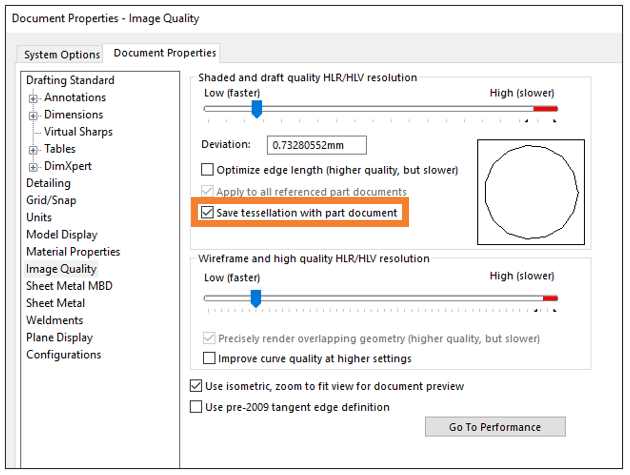
It’s worth noting that this option is only relevant for part models. It’s grayed out for assemblies. Assemblies appear to automatically save the tessellation data for the active configuration so that it can always be presented in a viewing tool, even if the referenced part models have “Save tessellation” disabled.
Minimize Triangles to Maximize Save Performance
It is also important to mention that the Image Quality value on the slider impacts the file size if the tessellation data is being saved. The image below shows how the engine head responded to this parameter. Higher image quality means larger files and potentially longer save times. (It also could mean more time waiting for the part to rebuild, as I found earlier this year while working on an article for pattern performance.)
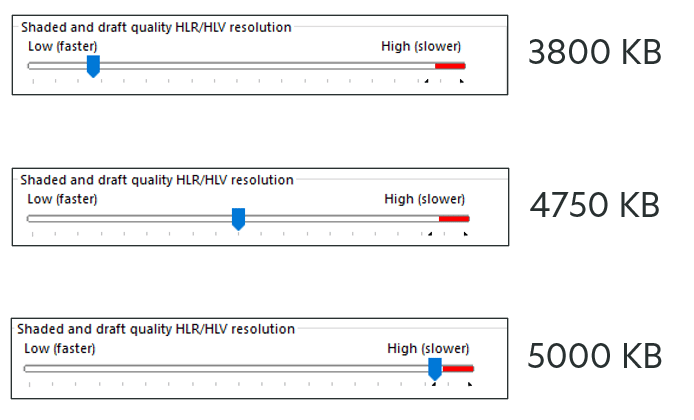
Again, turning on “Save tessellation” will only save the active configuration’s display data by default. If you then open the model in eDrawings, for instance, you’ll only be able to look at the active configuration; it won’t let you switch to any of the others because it doesn’t know what those configurations look like.
If you want to have access to other configurations as well, you can create a Display Data Mark for them. Similar to the Rebuild on Save Mark, you’ll see options related to this feature when right-clicking the top-level file name in the ConfigurationManager.

Any configurations with Display Data Marks will be available within eDrawings or other viewers along with the active configuration. (If it’s a part model, “Save tessellation” must be enabled.) These configurations will have a part or assembly icon with an eye in the ConfigurationManager.

If you want to remove your Display Data Marks and throw out saved display data, you can use the “Remove Mark and Purge Data for All Configurations” option. Again, this will only purge data from the inactive configurations. SOLIDWORKS saves the active configuration’s display data according to your Image Quality settings.
Another tradeoff. If you like to preview a part in viewing tools like eDrawings or with PDM in File Explorer, you’ll need to enable the “Save tessellation” setting and, optionally, add Display Data Marks for any configurations you want to always have access to. If you don’t care about viewing the model outside SOLIDWORKS though and want to cut down your file size and save time, you can disable “Save tessellation.” Because it’s a Document Property, you can adjust this option on a file-by-file basis. So, you can include the data when you need it and neglect it when you don’t.
Conclusion
So, configuration feature data and display data both have a significant effect on maximizing save performance. You can avoid some of these pitfalls by paying attention to the icons in the ConfigurationManager and minimizing the number of checkmarks. Also, make sure your system ignores the tessellation details used to generate the model graphically to minimize triangles. That being said, it’s important to recognize the consequences these changes might have, such as slowing down the switch from one configuration to another or preventing the usage of previewing tools like eDrawings.
Of course, if you are having persistent performance issues and want more in-depth analysis, give us a call.
Anthony Sandri
Application Engineer
Computer Aided Technology

 Blog
Blog